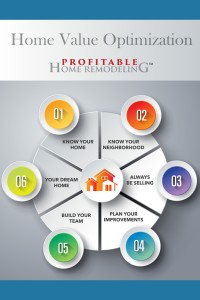After serving our country in the military my father and grandfather won Homesteads rights in the Klamath Basin.
A centuries-old practice in the West. . .
Flash forward to today. . .
You’ve probably noticed, it’s hard not to, House Flipping has become a very hot topic.
Reality TV shows, with varying degrees of popularity, are now showing us how it’s done.
Investopedia defines it this way:
DEFINITION of “House Flipping: A type of real estate investment strategy in which an investor purchases properties with the goal of reselling them for a profit. Profit is generated either through the price appreciation that occurs as a result of a hot housing market and/or from renovations and capital improvements.”
Every so often I catch myself tuned into one of these shows. The producers really know how to hook the audience.
Eventually, I come to my senses, because I know the plot is always going to end the same. The ‘investor’ always makes a pot of money, even after all the drama.
Now, anyone with common sense knows it doesn’t always end that way.
There are a large number of variables that must be managed in order to walk away with the pot of gold.
While researching the house flipping concept I discovered an article that caught my attention.
How to Pay Zero Taxes, Minimize Risk Keep Your Sanity While Live-In Flipping
Published on BiggerPockets.com
The term House Flipping has been around for quite some time.
In fact, it’s similar to homesteading I mentioned earlier and I’ll get to that in a minute.
I’d never heard the term “Live-In Flipping” before, and a quick google search didn’t give me much for that term either.
So I took it on myself to define it this way:
DEFINITION of: “‘Live-In Flip’ A type of real estate investment strategy in which a homeowner strategically makes home improvements designed to increase the value of the property. Profit is generated by the appreciation of property value over time, and the ability to avoid capital gains taxes with the use of the Tax Relief Act of 1997.”
Humm, that’s what Profitable Home Remodeling is all about.
We Simply Call It Home Value Optimization.
The BiggerPockets.com article written by Mindy Jensen contained some good tips and some great insights from a “live-in flipper”.
What really caught my attention were the comments:
MARGARET SMITH Comments:
“This is how I started also, back in our first house purchased in Atlanta in 1979. WE bought the worst house in a great neighborhood, with some seller financing, so not only did we gain sweat equity over our 2 years of work, we had great appreciation. We were absolutely flummoxed at the gain we pocketed at sale. I have now done this several more times, completely taking my time as I go, and have never done poorly with this.”
CHAD CARSON
“LOVE this strategy, Mindy! I don’t know why more people don’t take advantage of this, at least for a season of their live. When you can flip 2-3 houses and own your home free and clear or have a chunk of equity to start your rental business – why wouldn’t you???
Oh yeah, it’s hard. But so is getting stuck to a job you don’t love for multiple decades. And so is not having enough money to retire in comfort. Seems like the dust is worth it to me.”
JEROME KAIDOR
“I’ve done this too. Sort of. My first house, bought in 1980. Lived in it for 16 years and built a 460-foot house addition. Sold it for $200K more than I paid. Of course, some of that was just 16 years of appreciation. We bought another house in a better neighborhood. Replaced endless rotted decks, remodeled the kitchen, lived there for 15 years, sold it for $500K more than we paid for it.”
Three great comments from successful ‘live-in flipping’ homeowners.

The process is pretty straight forward, but success is smoother if you have a roadmap.
That’s why we developed Profitable Home Remodeling
To build a community of people who are working their way through the process together.
No matter what you call it the process of building wealth with home ownership is not new.
Now, what’s that Homesteading thing all about?

My family history includes the original form of ‘live-in flipping’ it was known as Homesteading.
The process got its’ start with help from the federal government with the passage of the
1862 Homestead Act by Abraham Lincoln.
The photo on the right shows the “first homesteader”, who settled in Beatrice, Neb. 1863.
Courtesy The Library of Congress Researchers
The Homestead Act encouraged Western migration by providing settlers 160 acres of public land. In exchange, homesteaders paid a small filing fee and were required to complete five years of continuous residence before receiving ownership of the land.
But it wasn’t until the early 1900’s that my family was involved in this process in Tulelake California where my grandfather won his drawing.
The “Homestead” is still in my family to this day.
In 1917, the U.S. Reclamation Service (renamed the Bureau of Reclamation in 1923) offered 3,000 acres of land for homesteading in the Klamath Reclamation Project near Tulelake, California, just south of the Oregon border. Each homestead was approximately 80 acres and would be served by an irrigation canal. The homesteads were distributed by a drawing, with applications limited to Americans or naturalized immigrants who could demonstrate their ability to farm and who did not intend to resell the land. Nearly 180 applications were submitted for the April 25 drawing.

Tulelake California 1947
Courtesy Oregon Historical Society
The Tule Lake homestead drawing in August 1946 attracted 2,150 applicants but offered only 86 units. This drawing, however, was limited to World War II veterans, men and women, who provided proof of farming experience and a certificate of good health, owned less than 160 acres, submitted reference letters, and had accumulated at least $2,000 in assets.
After discharge from the Navy at the end of World War II, my father also won a homestead drawing in the Tulelake area.
Making my father and grandfather the only father-son group to win homesteads in this area.
No matter what you call it – you can build wealth with this process.
We call the process of ‘live-in flippin’ – Home Value Optimization!
Your home is an investment and is most likely the biggest investment your family will ever make.
With a little effort, your family can build their wealth with this process.


